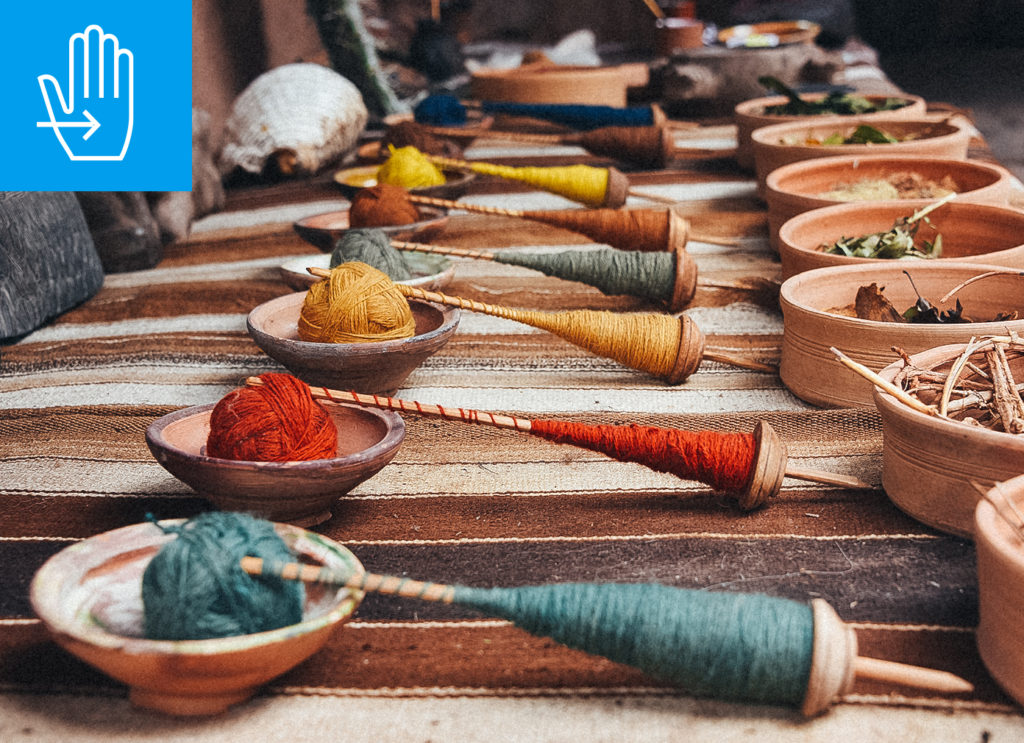
When you visit Peru, you’re surrounded by a visual explosion of colors and textures woven into the very fabric of life in the Andes.
The landscape itself displays a tapestry of fields and crops once described to me as “the clothes of mother earth,” while the textiles of Peru follow a vibrant journey start to finish, depicting stories and images related to individual lives and Andean culture. (Check out our video here.) But before you get to Peru, let’s see what you can design at home!
To share this experiment with your students, you can share this article, download our student PDF, or just choose a part of this lesson to share!
Today, we are going to experiment with dyeing fabrics with ingredients that you can find in your home. You can use foods and spices from your pantry to change the color of paper or cloth. Some examples of foods you can use to make dye are turmeric, cranberries, red cabbage, and skins from red or yellow onions—but look around your house and try other food items you think might work!
To get started:
- Collect the dye materials you want to use. Make a prediction for the colors that you’ll derive from each one.
- For this experiment, you will need a separate pot for each color, food, or spice that you are going to test. Pro tip: There’s no set formula for the amount of dye material to water. Some spices, like turmeric, require less dyestuff, while other foods, such as onion skin, might require more.
- Start with two cups of water in each pot, then add the dye material.
- Bring to a boil and simmer for 30 minutes.
- Start with dipping paper into each dye bath and see what happens.
- Continue to boil, or add more dyestuff, until you’re satisfied with the results.
- Test as many materials as you have. You can even let them sit in the dye bath overnight!
Let’s reflect: Were your predictions correct? What was the most effective dye? What surprised you?
Still looking for more? You can experiment with 2 other variables: mordents and materials. Don’t forget: Always set aside a sample material from the original dye bath to compare.
Mordents
These are things that help “fix” the color to the cloth, or make the color stick. Some examples are lemon juice, vinegar, and salt—but, again, feel free to experiment!
To get started:
- Pick out your mordent. Try using an afterbath of salt, lemon juice, lime juice, or any type of vinegar.
- Take one of the dye baths you’ve created and bring to a boil in two separate pots, or pour into two separate bowls once the liquid is hot.
- Immerse the material you are working with into each bowl of dye bath, and then add a different mordent to each bowl. For example, put salt in one, and lemon in the other.
Let’s reflect: What were the results? Might you get different results using a different dye bath? Did different materials respond in different ways?
Materials
What do you want to dye? Make sure you’re not experimenting with anything you’re not okay with changing color, so find some old clothes, paper, or other supplies you have around.
To get started:
- If you have a lot of materials that you’re curious to test, you can simply apply them all to what you’ve done so far.
- Try dipping different materials in the different color dyes. If you want to go further, try them again using the mordents.
Let’s reflect: Do the materials you’re testing respond differently in the same dye bath or with different mordents?
Now that you’re a master of your process, the world is yours! Try creating designs, or continue experimenting with more colors. Make sure to share what you’ve created with your class.
Related articles
